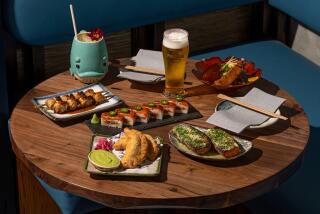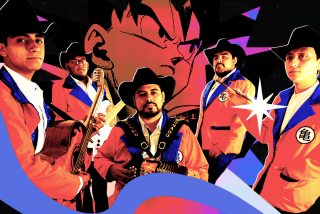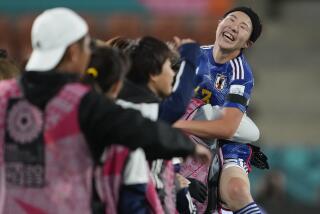DANCE REVIEW : ONDEKO-ZA SHOWS COMPANY SPIRIT
Ondeko-za is both the original name of a popular Japanese drum ensemble now known as Kodo and the name of a new group formed when artistic differences and the pressures of Kodo’s success led to conflicts, expulsions, divergent paths.
Communal living (currently in the Nagasaki mountains) and communal running (with, as before, the Boston Marathon an annual challenge) give the eight men and four women of Ondeko-za a company spirit that embraces yet extends beyond imposing individual skills as drummers, flute and shamisen players, mimes or dancers.
Clearly, theirs is a visionary quest for a fusion of ultimate purity and potency. In their performance Wednesday at the Wadsworth Theater in West Los Angeles, merely addressing a drum--preparing for the first blow--became heroic. You could see the drummers summoning their full resources, growing worthy of the act and then acting in something like cold fury.
Whether drumming from an excruciating layback position (halfway between sitting and reclining) or reaching above his shoulders for an extended assault on the 700-pound “demon drum,” Youichi Hashimoto was clearly enduring some metaphysical test. But less grueling moments in the program (Marco Lienhard’s deeply fanciful solos on the shakuhachi , for example) also looked fully invested--and with more than just energy.
Though the drums were never silent for long, Ondeko-za’s program managed to offer considerable variety and to reflect the same sense of high ideals as the performances. Sometimes virtuosity seemed the point (as in the pounding, plucking, and muted quivering of a shamisen solo), yet elsewhere it became concealed by the sense of spontaneous high spirits.
The character comedy “The Watermelon Thief,” for instance, developed through masterful, dance-like stylizations of walking: nimble, bowlegged prancing for Ichiro Inoue as the thief, a smug, weighty waddle for Kunihiko Hamada as the landowner. Yet no sense of display intruded; the piece played as a sketch, an easygoing interlude between drum numbers.
Remarkably, the adaptations from Japanese folk culture and theater-dance remained purged of traditional sexism. Even in decorative fan or parasol dances the women looked fiercely empowered and in one dance-drama Yasuko Takakubo neatly dispatched hordes of male assailants during a choreographed battle that seemed to belong more to the Peking Opera warrior-woman genre than familiar Japanese theatrical idioms.
But it is the layering of drum patterns and sonorities in intricate compositions that represents the key Ondeko-za experience. Ornamented with plucked strings, woodwinds and cymbals, the drumming ranges from the tattoo of small instruments to the thunderous, primal impulse of the demon drum mounted on a wagon 10 feet off the stage.
But something more than musical occurs with these instruments, and that something--the sense of people placing their lives on the line--makes Ondeko-za II as transcendent as the original company was in its local debut nine years ago. Accept no imitations: This is the real thing.
Documentary film makers, take note: Leader Den Tagayasu has just announced plans for Ondeko-za to run across America, nonstop, for three years starting in April, 1988--running during each day and, where possible, giving performances at night. If these people run like they drum, this American odyssey should leave a trail of foot-sized craters from coast to coast.
A fashion report: The men of Ondeko-za no longer drum in loincloths. That celebrated practice of the company’s early years, a spokesman revealed rather wryly, came not from any Japanese cultural legacy but a suggestion by French couturier and onetime company sponsor Pierre Cardin. In the new Ondeko-za’s return to genuine basics, a blue-black backless aproned tank top over matching trousers is the approved apparel for athletic percussionists.
Ondeko-za appears at the Wadsworth through Sunday and then gives two performances on Dec. 6 at the Japan America Theatre in Little Tokyo.
More to Read
The biggest entertainment stories
Get our big stories about Hollywood, film, television, music, arts, culture and more right in your inbox as soon as they publish.
You may occasionally receive promotional content from the Los Angeles Times.










